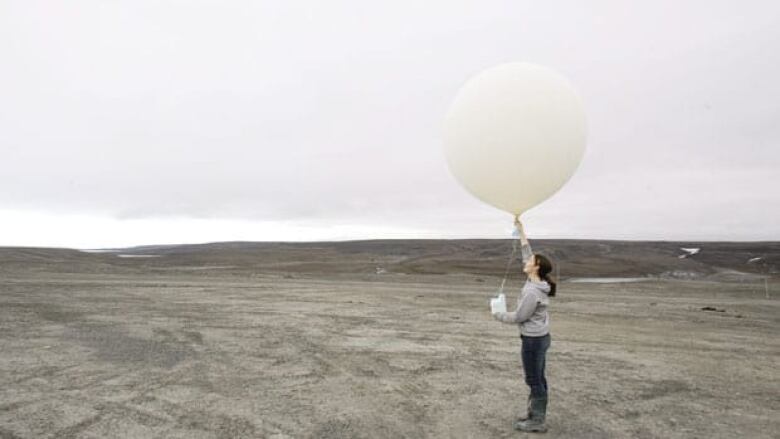Canada's ozone tracking in jeopardy

International scientists are expressing concern that cuts at Environment Canada could hobble a program monitoringozone, acomponent of the atmosphere that protects living things from the sun's ultraviolet rays.
Friday has been proclaimed by the United Nations General Assembly as the International Day for the Preservation of the Ozone Layer, to commemorate the signing of the 1987 Montreal Protocol. The international agreement is intended to stop human-made chemicals from depleting the ozone layer and boosting the risk of health problems such as skin cancer, cataracts and immune system damage. The agreement requires participating countries to monitor the ozone layer's recovery and issue a scientific assessment every four years.
But this year the day comes amid international worries over Canada's apparent plan to shut down:
- A network of 17 ozone monitoring stations across the country that take balloon-based measurements of the atmosphere.
- The World Ozone and Ultraviolet Radiation Data Centre, the international database that makes archived ozone data from around the world available to scientists.
"They play a very important role within the monitoring of the ozone layer," said Johannes Strahelin, the Swiss researcher who chairs the World Meteorological Organization's ozone science advisory group.
This past spring, ozone monitoring showed arecord ozone holeover the Arctic, partly due to the effects of climate change, and the World Meteorological Organizationwarned that could lead to increased exposure to ultraviolet radiation in the Northern Hemisphere.
The Canadian cuts received international attention this week when an article about them appeared in the prominent scientific journal Nature.
When asked to confirm or deny the cuts, Environment Canada said in a statement emailed to CBC News that all government programs are reviewed regularly to ensure "they are effective and efficient, respond to the priorities ofCanadians and are in line with core federal responsibilities." It added that programs that fail those tests are "adjusted" or have their funding reallocated.
"At this time, we are not in a position to identify, which specific programs will be subject to adjustments or reallocated funding," it added.
Nothing has been 'cut,' Environment Canada says
On Friday, Environment Canada spokeswoman Melissa Lantsman sent another email specifying that "nothing has been 'cut'. We are optimizing and streamlining the way we monitor and measure ozone."

In August, Environment Canada informed the union, the Professional Institute of the Public Service of Canada, that it planned toeliminate around 700 positions, though it said roughly 300 of the affected people would be offered positions elsewhere in the government.
Gary Corbett, president of the union representing the scientists, said the union has reviewed the list of people affected.
"We note that the key scientists who are involved in the ozone program are on that list," he said.
According to ozone scientists both within and outside Canada, most staff in the ozone group, including the program leader, received letters from the department informing them that their job functions will cease. The person in charge of the World Ozone and Ultraviolet Radiation Data Centre received a similar letter. However, so far, Environment Canada plans to maintain the "technical capacity" for ground-based ozone measurements used to produce the UV Index for weather forecasts.
"They [Environment Canada scientists] have been quietly and informally letting their colleagues know because it affects everything we do, both in the community in Canada, but also internationally," said Tom Duck, an atmospheric scientist at Dalhousie University in Halifax.
The cuts come just one year before Canada is set to host an international meeting of ozone scientists that takes place every four years.
Corbett said the letters were sent out more than a month ago, and the department must determine whether the affected programs will continue by the end of October. He noted that many are run by a single scientist.
Canadian data fills gaps
Ross Salawitch, an ozone scientist at the University of Maryland, said the loss of the Canadian data will create a gap in international data needed to monitor the recovery of the ozone layer, track ozone loss in a single air mass as it moves from country to country, observe changes in the recovery due to climate change and prepare the scientific assessments required by the Montreal Protocol.
He said Canada's ozone monitoring network is so long-running that it is used to validate the ozone data from different satellites launched at different times: "It's kind of the glue that holds the satellite record together."
Strahelin said it also fills in gaps in data collected by satellites, which cannot measure ozone during the polar night. He was also concerned about the future of the international ozone database. Moving it to another country isn't as simple as putting it on a CD and sending it somewhere else, he said.
"It's not just only a database," he said. "There's much knowledge of the person leading the database" such as how to handle the data.
Oilsands, pollution monitoring affected
Michel Bourqui, an atmospheric scientist at McGill University in Montreal, said no other source of data exists that could replace the balloon measurements.

"This network is the only source of measurements of ozone, detailed measurements of ozone through Canada for the first 20 to 30 kilometres of the atmosphere," he said. "If we lose that, we lose not just our monitoring of the ozone layer, which is absolutely essential, but also lose capability to find sources of ozone."
Ozone sources can lead to the production of smog and pollution close to the ground that can induce respiratory and cardiac problems.
Duck said the government'srecently expanded oilsands monitoringprogram wasalso going to rely on some of the ozone measurements.
"Its surprising that they would announce a program to monitor oilsands, but at same time be gutting Environment Canada of the capability to implement it."
He noted that staff cuts at Environment Canada will also affect a large number of other environment monitoring programs, including the solar radiation program that also feeds into the UV index, aircraft measurements of the atmosphere that were also to be used in oilsands monitoring, and a program to look at toxic substances such as pesticides in the atmosphere.
"The problem goes far, far beyond ozone. We're talking about our basic ability to monitor our environment and respond to problems when they occur," he said. "This is kind of like taking the batteries out of your smoke detector."
The Canadian Meteorological and Oceanographic Society, the scientific organization for 850 environmental scientists including many at Environment Canada, contacted the environment minister inJune asking about the apparent cuts, but has yet to receive a response, said Norman McFarlane, president of the group and a former Environment Canada scientist.
"There is considerable lack of transparency," he said. "The government has not been clear on what programs it's looking at, what activities will be reduced, what will be closed down.
"You get the impression that they basically have not thought through what they are going to cut. The loss of the ozone network would be a very serious matter."
He added that an international response is being mounted by the scientific community.
"We're really hoping that that response will essentially lead to a reversal of that decisionif it was in fact a decision."












_(720p).jpg)


 OFFICIAL HD MUSIC VIDEO.jpg)
.jpg)



























































































